Introduction
When violent crimes are committed, it is not unusual for the participants to be injured. If these injuries are accompanied by blood flow, distinctive bloodstain patterns may result that can be used to provide investigative information about the activities which occurred during the commission of the crime. These distinctive bloodstain patterns occur because of the physical properties of the blood and how it reacts when acted upon by physical forces. The analysis of these patterns can provide the investigator with information about the direction of travel of the blood, the level of force used to put the blood in flight, the location of the blood source which was acted upon to create the pattern, movements during bloodshed, movements after bloodshed, and activities during bloodshed. Bloodstain pattern analysis studies how different forces and activities influence the creation and appearance of the bloodstain patterns, so that they can be interpreted as part of the crime scene investigation.
Bloodstain Characteristics
Many factors affect the size and shape of the blood drops. When blood passively drips off of a surface and falls on to a smooth hard horizontal surface, the resulting bloodstain will be round. As the blood falls through the air, it takes the shape of an oscillating sphere. The blood droplets will not break up in the air as they fall due to gravitational force alone. Additional forces, however, can break the drops apart. The diameter of the bloodstain is dependent upon the distance the drop falls to the horizontal surface as well as the volume of the blood drop. As the distance of the fall increases, the diameter of the bloodstain will increase until it reaches a maximum diameter. The maximum diameter for the bloodstain occurs after the drop has fallen approximately 1.8 m (6 ft). The volume of the drop of blood also affects the diameter of the bloodstain. As volume increases, so will the diameter of the resulting bloodstain. Early research identified the average volume of a drop of blood as 0.05 ml. Subsequent research determined that the average volume of a drop of blood varies depending on the surface characteristics of the object that the blood drips from. Blood drops fall off of a surface because its volume increases to the level where the pull of the Earth’s gravity overcomes the viscosity of the blood and allows the surface tension to break. The shape and finish of the surface the blood falls from affects the blood volume that is needed for the surface tension of the blood to break and allow it to fall.
In addition to droplet volume, distance of fall and the blood source surface characteristics, other factors affect the size, shape and appearance of the bloodstains. Droplet size is a factor of how much force was imparted on the blood source to put it in flight. The viscosity, specific gravity and surface tension of blood make it resistant to being broken up into drops. When an external force is imparted on static blood, it will cause some of the blood to react and be put in flight. The distance the drops of blood fly through the air is dependent upon how much force was used to create the drops, the size of the blood drops, and air currents. In low force events (sometimes referred to as low velocity), the number of blood drops put in flight is low and the size of the droplets tend to be large. The majority of the droplets will be larger than 3 mm in diameter, with very few having a diameter less than 3 mm. The distance these droplets travel from the blood source tends to be short. As the level of force or velocity increases, the number of blood drops put in flight and the distance they travel away from the blood source increases. The diameter of the drops decreases as force increases, with many of the blood drops being 1 mm in diameter. There will still be larger drops but these drops tend to travel a greater distance away from the blood source than the smaller 1 mm and 2 mm diameter drops. Small drops of blood travel less distance, as they lack the physical weight to resist the air currents and friction, and the energy which puts them in flight dissipates rapidly. The majority of the small blood drops will not travel more than 0.9 m (3 ft) from the blood source. When the level of force becomes extremely high, such as in gunshot spatter, many thousands of blood drops, which are 1 mm and less in diameter, will be put in flight. As distance from the blood source increases, the size of the droplets increases, but these droplets are small (2 mm and 3 mm) in comparison to the large drops created by a low force bloodspatter event. Many of the larger drops, which are created in these high force events, are the result of smaller blood drops colliding while in flight and combining into larger volume drops of blood.
Bloodstain shape is determined by the angle between the flight path of the droplet and the surface that it impacts (Fig.1). When a drop of blood strikes a horizontal surface from the perpendicular (at an angle of 90°, Fig.2), the resulting bloodstain will be round. As the angle between the blood drops’ flight path and the target surface decreases, the length of the resulting bloodstain increases and the width decreases; in other words, the bloodstain becomes longer and narrower as the size of the angle decreases (Fig.3). A blood drop that has impacted a target surface from an angle of 12° will be long and narrow (Fig.4). Also present on these long, narrow stains is a ‘tail’ (Fig. 4). As the drop of blood impacts the target surface, the main body of the droplet will stick to the surface. A small portion of the blood drop will tear off from the top and continue in a forward direction. This secondary spatter has the appearance of a tail.
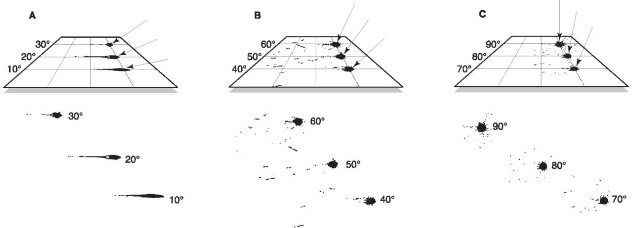
Figure 1 (A)-(C) The angles of impact of bloodstains against a target surface.
The tail is an important tool when reconstructing bloodstain patterns because it points in the direction the droplet was traveling in when it impacted on to the target surface. The shape of the bloodstain is also important in the reconstructive process. When the blood drop is deposited on to a surface that does not distort or alter its shape, the width-to-length ratio can be used to calculate the angle of impact for the bloodstain (Fig.5). The most frequently used formula for this calculation is:
Impact angle = arc sin (stain width stain length)
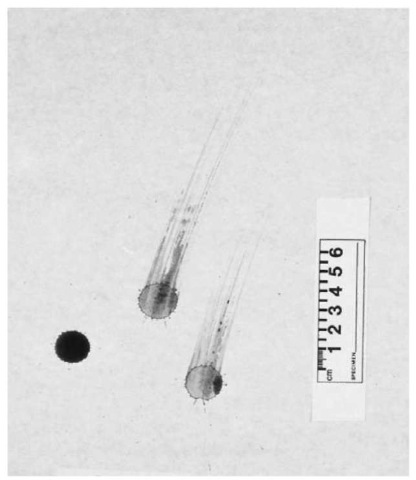
Figure 2 The shape of a drop of blood that impacted the target surface from an angle of 90°.
The direction of travel for multiple bloodstains in a pattern that combined with the angle of impact determinations, is used to find the location of the blood source that was impacted to create the pattern (Fig.6).
Surface effects on bloodstain appearance are very important. If a blood drop is deposited on a smooth, hard, nonporous surface, the shape of the bloodstain as well as the width-to-length ratio can be used for pattern reconstruction and interpretation. If the surface has characteristics which distort the appearance of the bloodstain or destroy its shape, then the stain will not be useful for a pattern reconstruction. Absorbent surfaces can also affect the shape and size of the bloodstain. These surfaces may alter the width-to-length ratio of the bloodstain and produce an inaccurate angle of impact determination; this data could prevent an accurate pattern reconstruction for locating the pattern blood source. When a drop of blood strikes a surface that is very rough, it will cause the blood drop to break up. Determining the angle of impact for these bloodstains cannot be done because it is impossible to measure the width and length of the bloodstain.
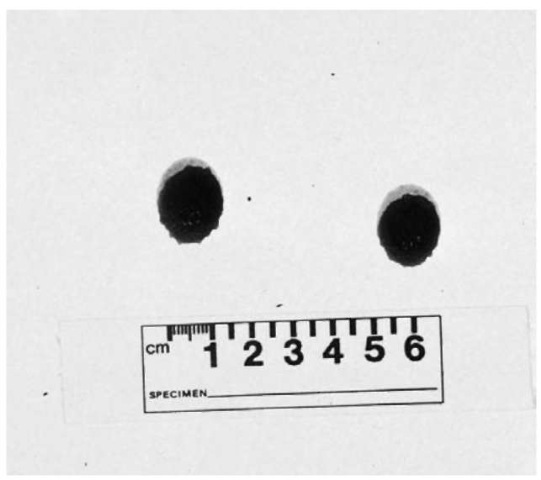
Figure 3 The shape of a drop of blood that impacted the target surface from an angle of 50°.
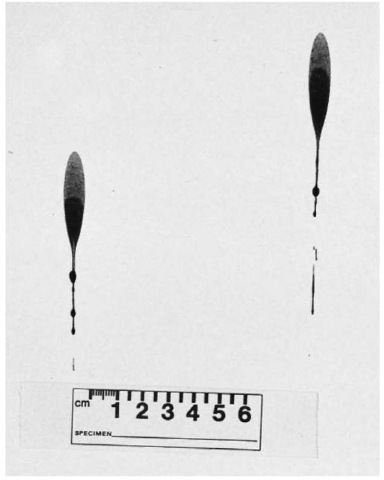
Figure 4 The shape of drops of blood that impacted the target surface from an angle of 12°.
Impact Bloodstain Patterns
Impact bloodstain patterns result when static pools of blood are hit. The energy of the impact is transferred to the blood, causing it to break up into droplets which are propelled through the air. If the droplets of blood hit an intermediate surface before the energy which put the blood in flight can dissipate to a level were gravity takes over, distinctive blood patterns will result (Fig.7). The appearance of these blood patterns is affected by the forcefulness of the impact, the volume of blood impacted, the surface characteristics of the blood source, the characteristics of the surface the blood is deposited on, and what is impacting into the blood to put it in flight (Fig.8). Impact bloodstain patterns will have round bloodstains in the portion of the pattern which is closest to the blood source. As the distance between the blood source and the bloodstains increase, the length of the stains increase and the width decreases. These bloodstains will also show the direction the blood drop was traveling when it impacted the target surface. These stain characteristics make it possible to reconstruct these patterns and determine the location of the blood that was impacted. The number of stains in the pattern, as well as the size of the stains, depends on the forcefulness of the impact. The majority of the small stains will be close to the blood source, while the larger stains tend to be longer distances away from the blood source. The number of stains in the pattern is dependent on how hard the blood was hit. Patterns which result from low force impacts have a low number of stains, the majority of which are large and have diameters greater than 3 mm. The patterns will cover a smaller surface area than patterns resulting from high force impacts. High force impact patterns have more bloodstains in the pattern and the majority of the stains that are close to the blood source will have diameters of 1 mm or less. The size and shape of the bloodstains and their distribution on the target surface make it possible to interpret bloodstain patterns and determine, within a reasonable degree of scientific certainty, the level of force used to impact the blood source.

Figure 5 Measurement of the blood drop to determine angle of impact.
Cast-off Bloodstain Patterns
When liquid blood coats the surface of an object that is being swung, the blood will be thrown off of the object’s surface due to the centrifugal force of the swing. If the blood is deposited on a target surface, the resulting pattern is called a cast-off pattern (Fig.9). The bloodstains in cast-off patterns line up with one another, giving the pattern a linear appearance. The bloodstains in the pattern that are closest to the start of the swinging motion will be round, while those at the terminal end of the pattern (cast-off at the end of the swinging motion) will be oval. If the pattern is deposited on multiple surfaces that are oriented differently to one another, such as a corner where two walls meet, the shape of the stains in the pattern will be round wherever the arc of the swing was perpendicular to the target surfaces. The width of the cast-off pattern is a factor of the width of the surface the blood is forced from.

Figure 6 Bloodstain pattern reconstruction.
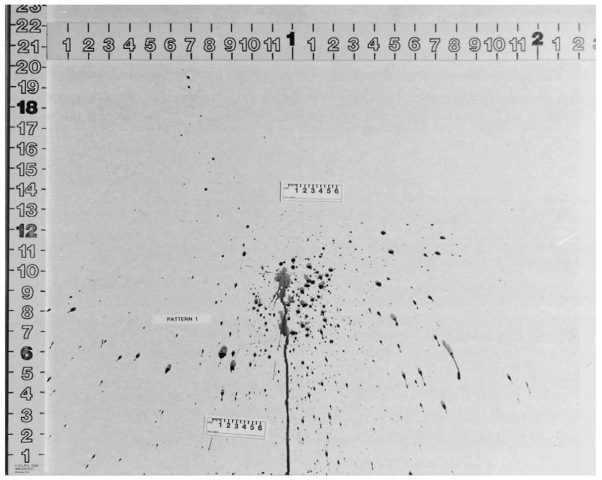
Figure 7 A low force impact pattern.
The general appearance of the pattern can be affected by the surface characteristics of the object, as well as by the motion and speed of the swing. Cast-off patterns usually occur only during the back swing away from the blood source. When a blood-coated object is swung forcefully, most of the blood will be cast-off during the back swing. The effects of inertia as the swing switches directions will force any remaining blood to be cast-off before the forward motion begins. Hitting a blood source several times can produce overlapping cast-off patterns. Since it is improbable that each swing will travel along the same arc, the overlapping patterns can be counted to indicate the number of hits after blood flow began. Cast-off patterns may exhibit a slight curvature along the length of the pattern. Under some conditions, this curvature can be used to indicate if the swing was left- or right-handed. Because cast-off patterns are easy to misinterpret, it is important to be cautious when evaluating these patterns for the number of hits or whether the swing was right- or left-handed.
Projected Bloodstain Patterns
Projected bloodstain patterns result when the blood is propelled forward against a target surface (Fig.10). In this situation, the force that put the blood in flight is traveling in the same direction as the blood pushing it from behind. The action is similar to that of water squirted from a squirt gun. The most common cause of these patterns is arterial injury. Blood flows through our bodies in a closed system of veins and arteries. When an artery is damaged, blood will be forced out of the injury with every beat of the person’s heart. The blood exits the artery under high pressure. If the blood strikes a target surface while the pressure or force is still elevated, the resulting pattern will have a very distinctive appearance. The center of the pattern will usually be one large bloodstain, or several large bloodstains. As the blood impacts into the target surface, the blood is broken up into hundreds of droplets which are splashed outward at an acute angle to the target surface, creating hundreds of secondary bloodstains that are very long and spindly in appearance. With each successive beat of the heart, more blood will be pumped out of the injured artery, but the pressure under which it is forced out decreases due to blood loss. The patterns that occur later will not hit the target surface as forcefully, and the secondary spatter bloodstains lose the spindly appearance. These lower force projected patterns can also occur when the projected blood travels an extended distance from the blood source to the target surface. As the blood flies through the air, the energy that propels it forward will decrease until the speed the blood is traveling at has slowed down to the pull of the Earth’s gravity.
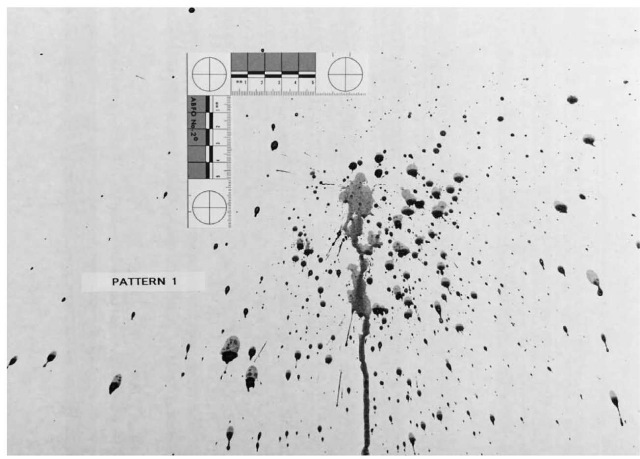
Figure 8 The characteristics of the bloodstain droplets near the center of the impact pattern.
Large Volumes of Falling Blood Patterns
Patterns that result from large volumes of falling blood will usually have a large central stain where the blood first impacts the target surface, with numerous secondary spatter stains radiating out from the impact site (Fig.11). Bloodstain patterns that result from large volumes of falling blood will vary in appearance due to the effect of the distance the blood falls to the target surface. Large volumes of falling blood fall due to gravity. As blood falls, its velocity increases. The velocity of the falling blood will continue to increase until it reaches terminal velocity, 9.8 ms-2, the downward pull of gravity. Studies done by MacDonell on 0.05 ml drops of falling blood showed that terminal velocity would occur when the drop falls 25.1 feet (7.7m). There is a rapid acceleration of the falling blood in the first 48 inches (1.2 m) of the fall, after which the acceleration is gradual until terminal velocity is reached. Blood that falls a short distance impacts the target surface at a low velocity, causing a less forceful splash and less secondary spatter. As velocity increases, the blood will impact the target surface more forcefully, the secondary spatter will be more numerous, and the bloodstains may start to become long and spindly. It is possible for bloodstain patterns from falling blood to be confused with projected bloodstain patterns. As the blood falls, its velocity increases until it impacts a target surface or reaches terminal velocity. The velocity of projected blood decreases until it impacts a surface or it reaches terminal velocity. If the distance traveled by the blood in these two situations is long enough, both volumes of blood will be traveling at the same velocity when they impact the target surface and the resulting patterns will appear similar.
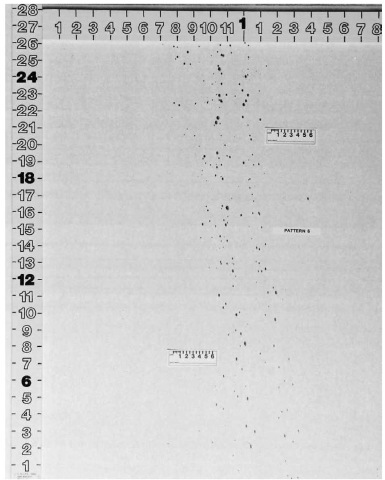
Figure 9 A cast-off bloodstain pattern.
Contact Bloodstain Patterns
Contact or transfer patterns happen when a bloody object comes into contact with an unstained surface. The blood on the object can be transferred to the surface, leaving a pattern. Contact patterns can be nondescript, lacking any characteristics of the origin of the pattern, or the pattern may exhibit some of the object’s characteristics (Fig.12). These characteristics can be compared to the object for the purpose of identification. The most common occurrence of this situation is bloody latent prints. These patterns are very important because they can be used to identify an individual and place him or her at the crime scene. They are also of importance when the latent print belongs to the subject and the blood the print is made from belongs to the victim. This situation indicates that there was some type of interaction between the subject and the victim after blood flow began. This type of comparison can also be done using bloody impressions from shoes, bare feet or any object that has individualized characteristics. Some contact patterns exhibit class characteristics, such as the shape of the object. These patterns can be useful for identification of the object type. If the object is wrapped while bloody, or the bloody object comes in contact with another surface, it may transfer blood, creating a pattern in its shape. Even though a pattern may lack details that can identify a specific object, the pattern is useful for investigative purposes.
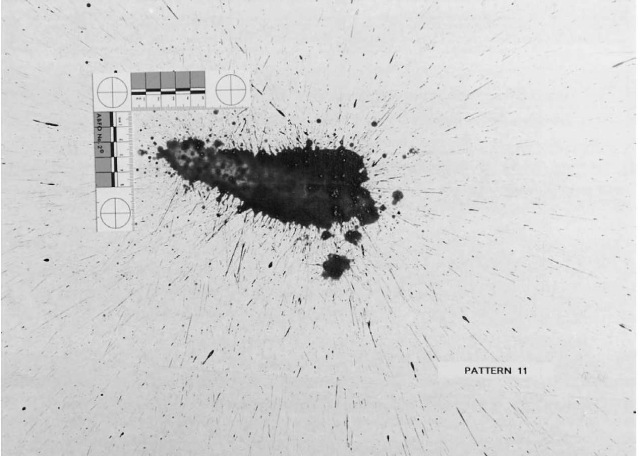
Figure 10 A bloodstain pattern that resulted from blood being projected at the target surface.
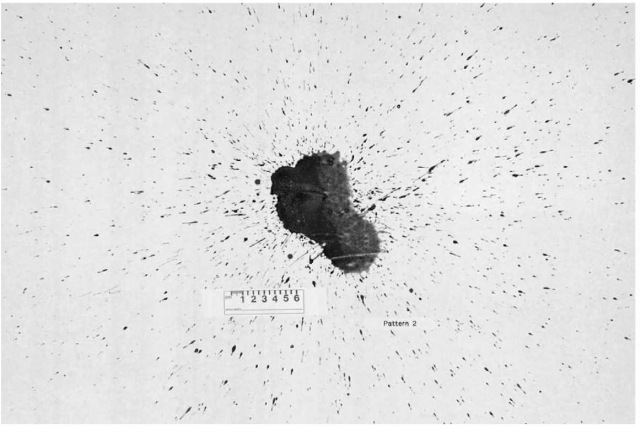
Figure 11 A bloodstain pattern that resulted from 5 ml of blood falling on to the target surface from a height of 1 m.
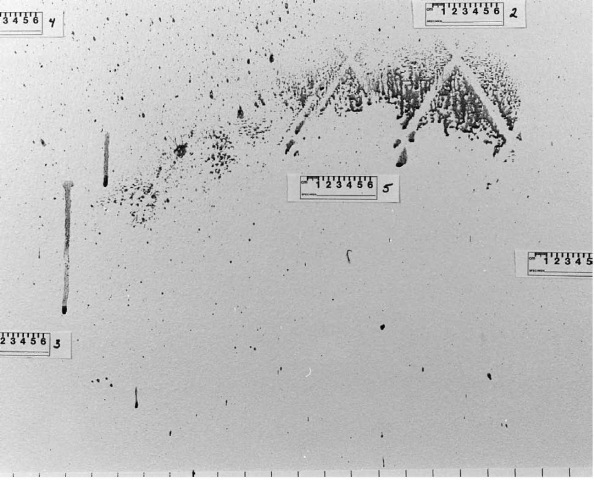
Figure 12 A transfer pattern that resulted from a blood-saturated mattress being leaned against a wall.
Blood Trails
When blood drips from an open wound or from a bloody object as it moves horizontally, a blood trail will occur. Blood trails are characterized by large blood drops in a linear pattern that has been deposited on a horizontal surface while dripping from the blood source. This linear characteristic is due to the horizontal movement of the blood source above the target surface while the blood drips due to the pull of gravity (Fig.13). The shape of the bloodstains and the degree of secondary spatter associated with the stains will be affected by the distance the drops fall and the speed of horizontal movement for the source of the dripping blood. These patterns can provide information about movements during and after bloodshed. For example, stains in a blood trail may show the direction of the blood source’s horizontal motion. If the direction of travel can be determined, the trail can be followed. This is extremely useful when an injured individual leaves the crime scene. If nothing is done to obstruct the flow of blood, the trail may be followed to determine the location of the individual. Trails can also provide information concerning the sequence of events at a crime scene or assist in locating important evidence. In addition, trails can be characterized by drag marks rather than droplets of blood. When a blood-coated object is dragged over a surface or the object is dragged through blood on a horizontal surface, a trail of smeared blood will result. The direction of the horizontal motion can be determined by examining the fine detail of the pattern.
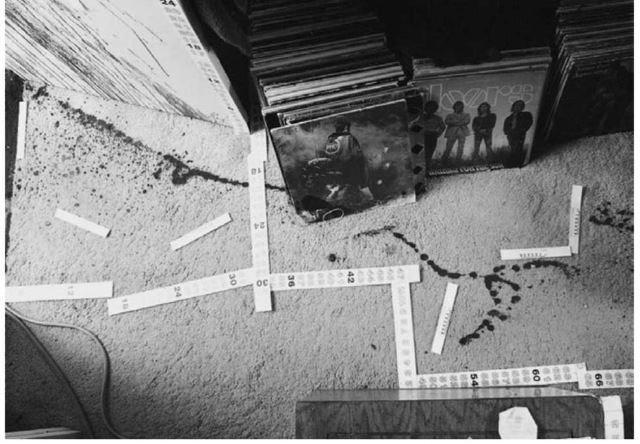
Figure 13 A blood trail.
Bloodstain Drying Times
Bloodstain pattern evidence drying times are affected by a number of environmental and physical factors. Blood volume is the main physical factor affecting the length of time required for the stains to dry. Large volumes of blood will dry more slowly than small volumes of blood when exposed to identical environmental assaults.
Environmental factors such as temperature, humidity, surface characteristics and airflow will affect the speed at which the bloodstain patterns dry. Warm temperatures will facilitate drying and accelerate the speed at which the blood dries. Cool or very cold temperatures will usually retard bloodstain drying times. Humidity also affects bloodstain drying times. When equal volumes of liquid blood are deposited in environments with contrasting humidities, the blood that is in the high humidity environment will dry more slowly than the blood in the low humidity environment. Drying occurs as the water in the stain evaporates into the surrounding air. In high humidity environments the air is saturated with water, retarding evaporation and increasing the length of time it takes for the stain to dry. The characteristics of the surface the blood is deposited on will affect bloodstain drying times. If the surface is one that protects the blood by limiting the amount of the bloodstain’s surface that is exposed to the environment, drying of the stain will be retarded and result in longer drying times. When the bloodstain is deposited on a surface that maximizes the amount of the stain’s surface exposed to the environment, the drying times will be shortened. Environments that allow a good airflow across the exposed surfaces of the bloodstain decrease the length of time required for the stain to dry.
Documentation of Bloodstain Pattern Evidence
Documentation and reconstruction of the bloodstain pattern evidence is a very important aspect of this forensic analysis. When the evidence and reconstruction are poorly documented, the conclusions can become very subjective. There are many different techniques that are currently in use for the documentation and reconstruction of bloodstain pattern evidence. Some bloodstain pattern analysts use computer programs that evaluate data from the bloodstain patterns and crime scene and determine the blood source locations. Many bloodstain pattern analysts do a physical evaluation and reconstruction of the bloodstain patterns at the crime scene, while others may work from the crime scene notes, sketches, and photographs.
Thorough and complete notes should accompany documentation and reconstruction of bloodstain pattern evidence. The notes should contain all observations and data that the analyst used to evaluate the bloodstain evidence. Contained in the notes may be police reports, crime scene reports, medical examiner reports and other forensic evaluations that may have been reviewed prior to the development of the analyst’s conclusions.
The photographic record should show a quality set of pictures illustrating the bloodstain patterns that were evaluated and the reconstructions that were done. Before starting analysis or reconstruction, the patterns should be photographed and sketched. The camera should be positioned perpendicular to the surface the patterns are deposited on. This limits distortion in the pictures and gives a truer representation of the appearance of the bloodstain patterns. It may be necessary to use artificial lighting to illuminate the bloodstain patterns being photographed. The lights should be positioned to provide even lighting across the entire area of interest. This will help avoid creating areas which are overlit (too bright) or under-lit (too dark). It is recommend that a handheld photographic light meter be used to assist in positioning the lights. After the bloodstain pattern evidence has been photographed in an unaltered state, measurement scales should be positioned around the pattern. Every picture should contain measurement scales that show the location of the pattern in relation to two fixed points. The measurement scales are also important in demonstrating bloodstain size data that are used in the bloodstain interpretation process. The bloodstain patterns should be rephotographed, showing the patterns with the measurement scales in place. Both of the aforementioned series of photographs should start with a general overview of the whole pattern(s) and then proceed to more specific pictures that show the detail of the blood droplets in the patterns. After the patterns have been documented in photographs, sketches and notes, the reconstruction may be performed. Each step of the pattern reconstruction should be photographed. Notes and sketches recording the data obtained should accompany the photographs from the reconstruction. Upon completion of this process, samples of the blood should be collected and submitted to a crime laboratory for analysis. Analysis of the blood samples may assist in the final interpretation of the patterns by helping the analyst connect the patterns to the individuals involved in the blood-spattering event.
